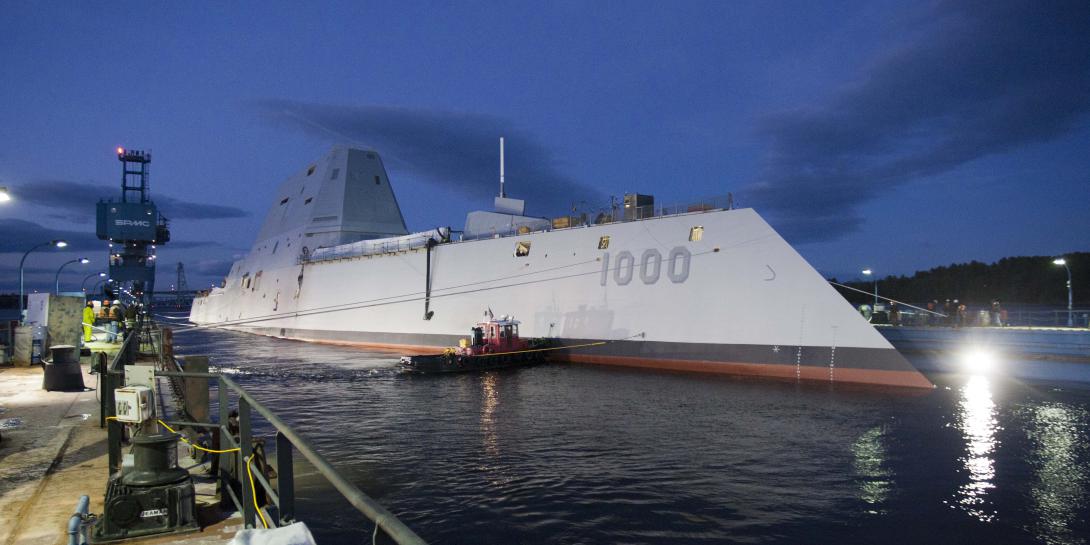Challenges to Crewing the Future Fleet
The modern technology-intensive fleet the U.S. Navy is putting to sea will require a new skill set for sailors who increasingly will be harder to recruit. The Navy needs the same high-technology talent coming out of high schools and colleges that the commercial sector seeks rigorously, and this competition likely will intensify for the foreseeable future.
New ships such as the Zumwalt-class destroyers rely heavily on technology to reduce personnel numbers. The Zumwalt crews only 130 people along with an aviation detachment of 28 sailors, compared to more than 300 on Arleigh Burke-class destroyers. The Zumwalt also is expected to incorporate next-generation weapon systems currently under development. With fewer sailors on board, those individuals need to possess more diverse skills as they multitask during operations.
These skills dovetail with the new technologies being incorporated into the naval force. New information capabilities are easily embraced by young people who have grown up with them. The same holds for training technologies that continue to become more elaborate with their objectives.
Yet, the advanced nature of naval technologies also poses a challenge for training. Some platforms, such as the F-35 fighter jet, are so elaborate that providing live training for all personnel—whether pilots or support crew—is quite complicated. So, virtual training must increase in size and scope to meet that challenge.
Vice Adm. Bill Moran, USN, is the chief of naval personnel and deputy chief of naval operations for manpower, personnel, training and education. Speaking in recent public forums, he describes the Navy as an analog organization that must operate in a digital world.
Previous Navy personnel criteria focused on quantity over quality, but that must change, Adm. Moran offers. Personnel costs are climbing, and so is the quality of recruits. Yet the ratio of senior staff sailors to junior warfighters is increasing. This is an unsustainable model over time, he states.
The Navy adds 40,000 people in any given year. Conversely, 40,000 people leave the sea service each year. About 33,000 people in the Navy are undergoing training, and more than 90,000 people move within the service each year. These numbers stand out against the backdrop of a total force of nearly 328,000 people.
With these figures in mind, the Navy must quicken its pace of learning among its sailors, the admiral says. The only way it will be able to afford future weapon systems and platforms is to reduce its personnel costs. Other than reducing salaries and benefits, the only solution is to reduce the number of personnel.
Adm. Moran notes that the generation of young people joining the Navy today has grown up in an information management world far different from that of their predecessors. Their access to information, their ability to learn and their talents at gaming all are methods that provide instruction in this information age. The Navy is slow to embrace this approach, he observes, and its training must change fundamentally to serve these people.
Several new approaches could help mitigate this shortcoming. These include more modular training and bringing instruction down to the waterfront or the platform. Technology will be the key to these advances, the admiral says. Whichever approaches are taken, future training must be delivered at the right time for the sailor. Accordingly, it must be mobile and deliverable to wherever sailors are located. Young people are likely to take advantage of this new training in ways far greater than anticipated, he adds.
The Navy is taking the step to bring in mobile, modular training, the admiral offers. This represents a departure from the traditional industrial model the Navy has relied on for years. It would help the Navy understand recruits’ talents and strengths to place them in the right ratings, he says. Also, local commanding officers would have more authority to make decisions based on conversations with their people.
The littoral combat ship (LCS) was built with training in mind from the front end, Adm. Moran notes. It has a significant simulation capability, which the Navy continues to upgrade. This capability is software-driven, so both problems and improvements can be addressed without major overhauls. This year, the Navy wants to introduce avatars into the LCS simulation, he adds.
Live virtual constructive training has great promise, the admiral adds. However, it is lagging for a lack of a common standard, which would drive down costs and increase its benefits.
To work toward this, the Navy has established a vision known as Sailor 2025. That is the target date for delivering more efficient training pipelines, which includes having a better understanding of each sailor’s talent. One element would modernize policies and information technologies that support data mining, data analysis and predictive analytics. Another, known as ready relevant learning, would provide targeted training for the right sailors for the correct jobs. Adm. Moran notes that current naval schools are teaching young sailors how to work on 1950s-era valves and basic electronics that barely reflect the needs of the current—or future—fleet.
Junior sailors also seem to be frustrated by greater deployment lengths that upset stability in their lives. And, they often find themselves training the sailors next to them concurrent with carrying out their own duties, which makes both tasks more difficult. Adm. Moran offers that the Navy must train more effectively and faster to match sailors’ skills as they enter the fleet. And, the better the Navy can train sailors at sea in operational units, the sooner it will have a quicker rate of learning and a more effective force, the admiral says.
In the future, the Navy may be able to conduct kinetic operations at a range of as much as 1,000 miles, the admiral offers. Taking electronic warfare and cyber into account, the U.S. Navy will be face-to-face with its adversaries at a much closer range, and it must have sailors who can operate in this environment even if the fleet is hindered by enemy action.
Many systems are introducing the concept of fear and “fighting hurt” into training systems, which Adm. Moran describes as a key factor to be considered in future training. The admiral notes that great expansion in training technology is underway in the commercial sector, and the Navy’s resource sponsors in surface, aviation, submarine and health care currently are moving toward these technologies.




Comments